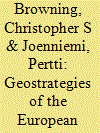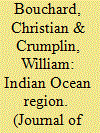| Srl | Item |
| 1 |
ID:
083745


|
|
|
|
|
| Publication |
2008.
|
| Summary/Abstract |
The debate about the European Neighbourhood Policy (ENP) has, in essence, been about borders and bordering. Such departures could contribute - and often do so - to a rather fixed geopolitical vision of what the EU is about and how it aims to run and to organize the broader European space. However, this article aims to retain space for viewing the ENP as a developmental and somewhat fluid process. A conceptual framework, based on outlining three geopolitical models and a series of different geopolitical strategies employed by the EU in regard to its borders, is hence employed in order to be able to tell a more dynamic story regarding the developing nature of the ENP and the EU's evolving nature more generally. The complexity traced informs us that various geostrategies may be held at the same time at the external border. Moreover, the dominance of one geostrategy may be replaced by another or a different combination of them with regard to the same neighbourhood. It is, more generally, argued that if anything it is precisely this dynamism that should be championed as a valuable resource, avoiding the tendency to close off options through the reification of particular visions of the nature of the EU and its borders.
|
|
|
|
|
|
|
|
|
|
|
|
|
|
|
|
| 2 |
ID:
130641


|
|
|
|
|
| Publication |
2013.
|
| Summary/Abstract |
The African littoral of the Indian Ocean is a significant part of the Indian Ocean region. In the context of the IOR-ARC, focus is given to the African littoral of the Indian Ocean Rim, which consists of 10 states plus three French island territories. However, an African Indian Ocean extended area of 24 states plus the French islands can be identified as part of the broader Indian Ocean region, to which we refer as the African Indian Ocean littoral and hinterland. This highlights the fact that the African land-locked states represent a pertinent and significant dimension to the relation between the African littoral and the rest of the Indian Ocean region. Overall, this African Indian Ocean littoral and hinterland is a region of low socio-economic development facing many challenges. Nonetheless, it is a region on the move, and some substantial improvements can be expected during the entire twenty-first century. The potential, and perhaps even expected outcome of a much larger and healthier population, a better performing and more open economy, and an increase in and more efficient management of maritime activities will set the scene for the rising significance of the African littoral to both the Indian Ocean region and the Indian Ocean Rim, thus also increasing its geopolitical and geostrategic significance.
|
|
|
|
|
|
|
|
|
|
|
|
|
|
|
|
| 3 |
ID:
189321


|
|
|
|
|
| Summary/Abstract |
As the world navigates the third decade of the twenty-first century, relations between the United States and the People's Republic of China can best be characterized as elevated great power competition or rivalry. Indeed, at the midpoint of the Joseph R. Biden administration there appears to be greater continuity than change in U.S. China policy and no indication of change in Beijing's policy toward the United States. Thus, a condition of heightened great power competition is likely to extend into the foreseeable future. This competition encompasses multiple dimensions and arenas with a considerable number of contentious issues and significant diverging interests. Key challenges in the bilateral relationship include the need to overcome deep mutual distrust and suspicion and reconcile competing geostrategies. For qualitative improvement not only must the two states address perceptions and misperceptions, but each needs to fundamentally alter their images of the other.
|
|
|
|
|
|
|
|
|
|
|
|
|
|
|
|